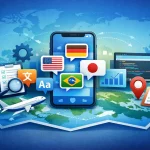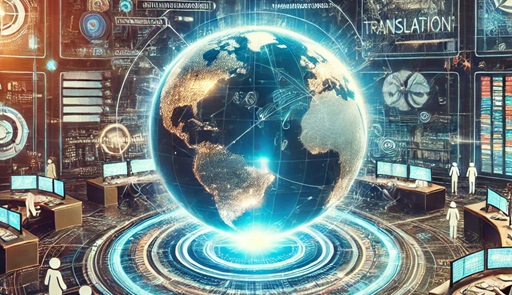Breaking the language barrier is now more possible than ever, thanks to Artificial Intelligence or AI translation. With powerhouses clamoring to produce the best translation technologies, it’s no wonder that the world is gearing up for the future of language learning.
Indeed, AI has quickly changed the way businesses operate, taking on small, repetitive tasks and automating different processes. While there’s still the debatable issue of machines versus human labor, it’s undeniable that AI holds the promise of a digital future.
What is AI translation?
Artificial intelligence translation follows the Natural Language Processing principles, which covers Machine Translation. MT refers to translating text from the original language to another by using a computer.
Machine Learning or ML is a pillar of AI in translation, studying a computer’s algorithms and their automatic improvement through experience. AI-powered translations rely on Neural MT, which mimics the human brain and allows learning by observing correlations between source texts and translated texts, consequently improving the output.
Reducing risks of inconsistencies with AI-based translation
When dealing with a long translation project, there is always the risk of repetitions. For example, working on translations for a device user manual will usually require a variation of the same texts for the same device. Save for the specs, most of the descriptions and instructions on a user manual will be the same.
Translators in the past had to manually check for inconsistencies after duplicating the exact text for different manuals. The repetition as time goes by becomes increasingly complex, although it may seem easy to handle.
Today, using AI for translation helps in reducing human error due to these repetitive tasks. It can automatically insert the translated content where it is necessary. This way, the translator can focus on boosting the quality of the text.
Collaborative human and machine effort
Artificial intelligence technologies still cannot rival the cognitive capabilities of humans, but it satisfactorily fulfills simple tasks that lessen the burden for the translator. AI can help save time by taking on some essential functions that would otherwise add to the workload of the human translator.
Additionally, AI may also lessen the cognitive fatigue caused by repetitive tasks. Translators can make smarter decisions and handle more complicated projects because the bots take care of the menial jobs.
AI works to reinforce the existing translation technology, enabling better tools to check and edit the first draft of documents. The algorithms used in AI become more innovative and more effective as time goes by.
Benefits of AI in translation
Why should you care about AI-powered translations? Several benefits await those who believe in the power of AI translation.
- Consistency
Translated texts by AI can be tuned according to the business need and assignment, which makes translations more consistent for every client. Also, the more you use AI in translation, the higher is its accuracy that can even compete with human translators.
- Fast and efficient
Artificial intelligence is fast in all aspects. Some machines can process a thousand times of data in half the time it takes humans to perform the task. AI can learn a sentence and deliver several translations in different languages depending on how it is programmed.
If your translation project prioritizes quantity over quality, you can rely on AI to fulfill repetitive tasks faster than human translators. It helps save time, especially for companies that lack human resources.
- Continuous learning
Machine learning is a continuous process, and AI engines are designed to take large datasets and understand cues from human feedback. AI algorithms can also be developed to learn from samples of translations and customer content.
Artificial intelligence can learn from various sources. Each new training dataset allows the AI to provide better translations over time.
- No cognitive fatigue
AI does not get tired. In terms of translation, this can mean AI can go on working without stopping. You can use the software and run it day and night, whereas human translators need ample rest to avoid cognitive fatigue.
- Specific vocabulary
AI-powered translations can satisfy the vocabulary requirements of a client. If the task requires using a specific terminology database, the AI can be trained to import these texts and customize the content by adding meta fields and new fields that create translations more in tune with the desired vocabulary. The result is a specialized copy that satisfies the client.
- Data retention
The data you input in AI remains for life. Unless a system crash or extraordinary errors occur, AI-enabled engines will not fail to translate the text if relevant information is retained. This feature is beneficial in accomplishing recurring and repetitive tasks.
- Downsides of AI-powered translation
While AI translation sounds perfect, there are still lapses in the technology, which is not fully mature. As such, AI has limitations that you must consider when using AI-based translation services.
- Initial training costs and time
An AI needs to undergo extensive training with large datasets to attain high-quality results, which means the process requires investing time and money. The initial cost of creating terminology bases or memory banks is significant, even though it will pay dividends as time goes by.
- Unreliability
AI is yet to achieve 100% reliability. While human translators cannot always be reliable, AI can suffer from inaccurate assertions and omission glitches, mainly when translating metaphors, idioms, colloquialisms, irony, sarcasm, and other unique language concepts.
- Reliance on human translators
No matter how advanced the technology gets, AI-powered translations will always rely on human input. It is unlikely to compete with human translators when dealing with persuasive texts. At the very least, translators must edit AI-translated materials for clarity and context.
Conclusion
The first step to an effective translation is to understand the context. Circle Translations is adept at performing such tasks, delivering translated texts with the voice and information to appeal to the target audience.
AI translation has many advantages, but nothing can remove human translators from the equation. If you need top-quality translation services, our team is always geared to offer you the best!
Subtitles

Professional and Accurate Subtitle Services for your Videos.
- Video subtitles specifically tailor-made for improving accessibility.
- Using highly experienced subtitlers with years of industry experience.
- Professionally written and expertly timed.
Translation

We help the world’s top companies translate their content in over 73 languages!
- We localize content for internet websites, games, travel, cryptocurrencies, and more
- Expand your global audience by adding different languages.
- We work only with qualified translators and experienced content creators
Audio translation

Ensuring full accessibility for Blind and visual impaired audiences.
- Visual descriptive events as they occur in the video.
- Working with top audio describers to perfectly describe what is happening on-screen
- Professional sound recording.














